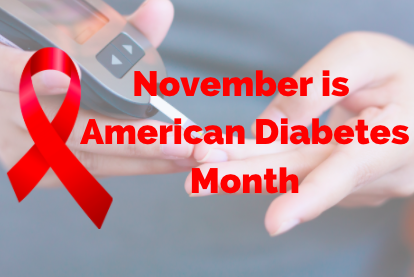Nourishing Lives: Empowering Health during National Diabetes Month
 Did you know that nearly 37.3 million children and adults in America are currently navigating life with diabetes? And that’s not all – an additional 96 million people have pre-diabetes, putting them at risk for developing Type 2 diabetes. It’s a staggering number that underscores the urgency of understanding and managing this condition.
Did you know that nearly 37.3 million children and adults in America are currently navigating life with diabetes? And that’s not all – an additional 96 million people have pre-diabetes, putting them at risk for developing Type 2 diabetes. It’s a staggering number that underscores the urgency of understanding and managing this condition.
Type 2 diabetes, the most common form, involves a rise in blood sugar levels due to either insufficient insulin production by the pancreas or the body’s resistance to insulin. Think of insulin as the key that unlocks your cells to let sugar in for energy. Without this key, sugar stays in the bloodstream, potentially leading to serious complications such as heart disease, stroke, kidney problems, eye issues, blindness, and nerve damage.
Given the prevalence of diabetes in our country, it’s crucial to spread awareness and knowledge. By empowering ourselves with information, we can take control of our health, paving the way for well-being and longevity. Let’s learn together and make informed choices for a healthier future!
Meal Planning for Diabetes
Anyone with diabetes needs to recognize that food choices can make a difference when regulating blood glucose levels. To keep your blood glucose levels near normal, you need to balance the food you eat with the insulin your body makes or gets by injection, and with your physical activity.
Carbohydrates, protein, and fats are all important to include in your meal plan each day. Carbohydrates in foods affect your blood glucose levels the most, therefore it is very important to know how much carbohydrate you are eating each day.
When focusing on carbohydrate counting, it is necessary to keep food records at each meal and to test your blood glucose levels each day, to see if your meal plan is appropriate for you. When you eat carbohydrates, they turn into glucose in your bloodstream. Insulin will help the glucose to enter cells, where it can be used for energy or stored for future use. Eating the same amount of carbohydrates daily at meals and snacks can help you to control your glucose levels.
Carbohydrate foods need to be spaced out over the day. You should have some carbohydrates in each meal and in any snacks. Even if you do not take insulin or diabetes pills, spacing carbohydrates makes it easier for your body’s insulin to work on the glucose that comes from the food you eat.
The following foods contain carbohydrates:
- Bread, crackers, and cereals
- Pasta, rice, and grains
- Fruit and juice
- Milk and yogurt
- Snack foods such as chips and pretzels
- Desserts such as cakes, pies, and cookies
It is best to speak with a registered dietitian and certified diabetes educator to obtain a plan that works for you.
4 Ways to Reduce Your Risk of Diabetes
Although it may seem difficult to prevent diabetes, it is not impossible! Taking the proper steps to improve your diet and adjusting certain lifestyle habits can significantly decrease your risk of diabetes.
If you’re ready to make a change, here are 4 ways to reduce your risk for diabetes:
- Move your body regularly. Frequent exercise has been known to help heart health, reduce blood glucose levels, and increase the body’s response to insulin. Although exercising can be intimidating, try moving your body in ways that work for you! Go on a daily walk around the neighborhood, take a bike ride, or even play your favorite song to dance to for 10 minutes.
- Eat a balanced and healthy diet. Eating a healthy diet is important for everyone. However, it is especially important when wanting to reduce your diabetes risk. Eating “balanced” simply means increasing fruit, vegetable, and high fiber foods in your meals, while reducing the intake of fat, specifically saturated fat, and limiting processed foods. Switch it up in your kitchen and try cooking a plant-based meal for dinner or make the swap from white pastas, rices, and breads to hearty, whole grain options.
- Quit smoking. Smoking is bad for one’s health in general, but research suggests that smokers are twice as likely to develop diabetes compared to non-smokers. Decide to quit today.
- Schedule regular doctors’ visits. As mentioned before, if you or someone you know is experiencing symptoms or you have a known history of diabetes – regular checkups with your doctor are a great idea! Stay on top of your health and make an appointment to meet with your doctor today.
As a Certified Diabetes Care and Education Specialist, I specialize in helping people that have diabetes or are at risk for developing diabetes learn how they can properly manage it. I believe in a weight-neutral approach, which means focusing on creating healthy habits and behavioral changes, without a focus on losing weight. My program called Healthy Living with Diabetes has helped so many live a life free of complications.
Now that you know more about diabetes and how I can help those struggling with managing their diabetes, I would love to hear from you!

Leave a Reply
Want to join the discussion?Feel free to contribute!